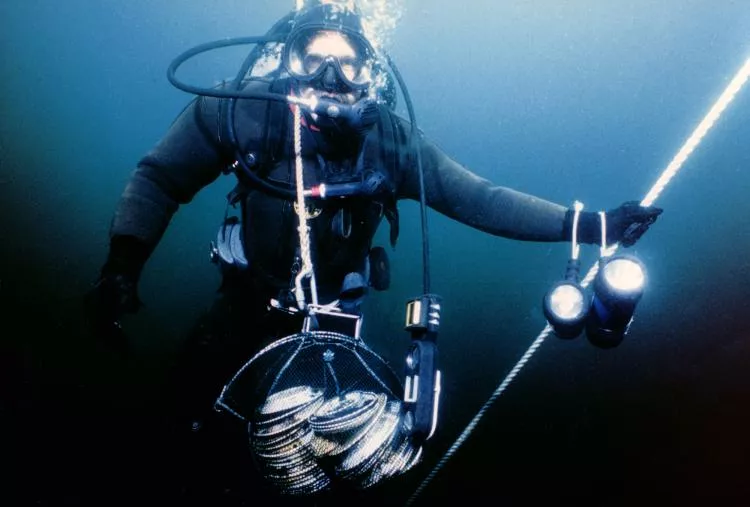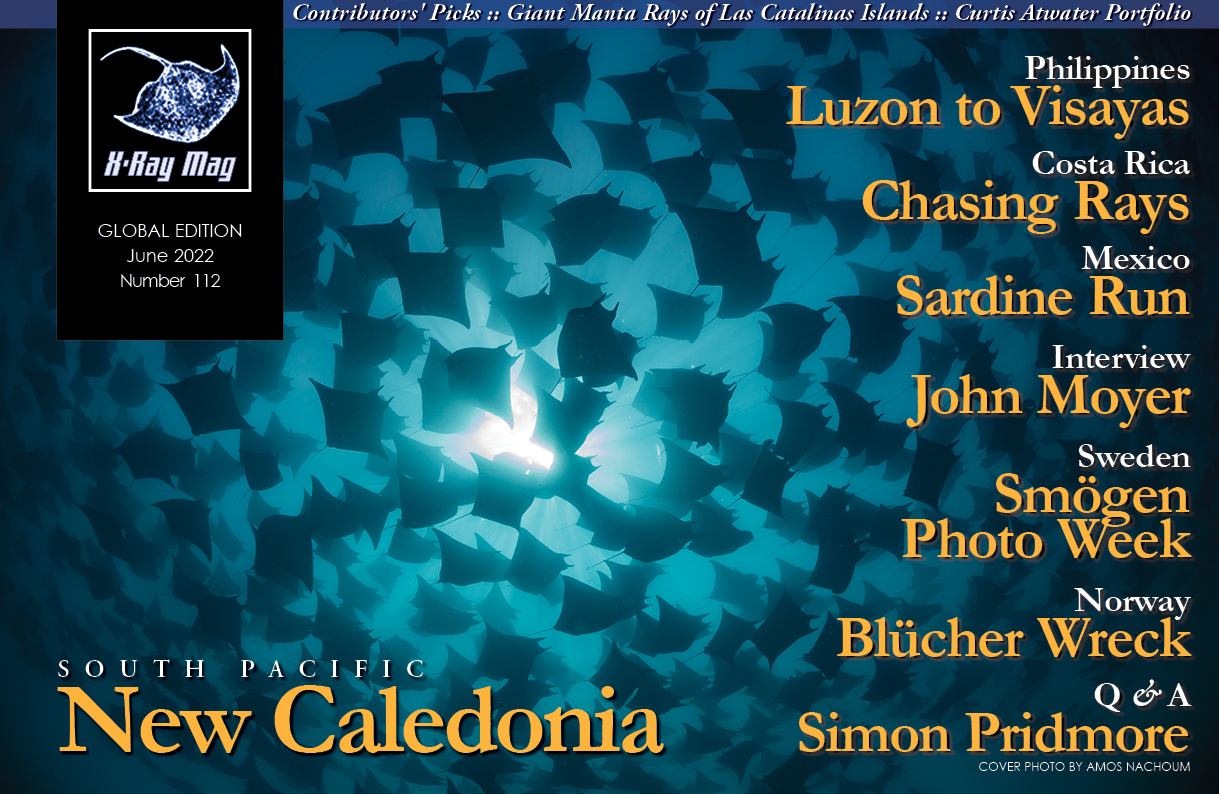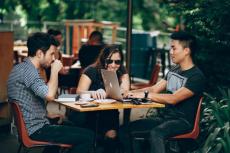Legendary American explorer John Moyer has dived many wrecks along the North American eastern seaboard. But his name is synonymous with the Andrea Doria wreck, on which he made over 120 dives in the '80s and ‘90s, salvaging artifacts, and conducted in-depth research. In this interview by Andrea Murdock Alpini, we gain insight into his life and deep relationship with the Andrea Doria.
Contributed by
John Moyer is a legendary American explorer. He will be turning 70 years old soon and has lived most of his life in Vineland, New Jersey, about a one-hour drive from the ocean. Throughout his life, Moyer has always had two passions: shipwrecks and motorcycles.
In the past, he would dive on shipwrecks all year round, and the only thing that would stop him would be high winds, or if the dive boat was frozen in ice at the dock. He has dived on wrecks all the way up and down the US East Coast, from Canada to Florida.
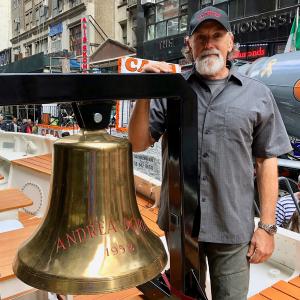
After numerous dives on the famous wreck, his name has been merged with the Andrea Doria forever in time. In his dives on the Andrea Doria, he salvaged parts of the wreck for various museums in the United States and conducted in-depth research on the ship during his lifetime. In the 1980s and ‘90s, he made over 50 trips to the Andrea Doria’s wreck site and made approximately 120 dives on the wreck.
If you ask Moyer what exploration means to him, his answer sounds like this: “To me, exploration is simply going places and experiencing things you never have before, whether it is underwater or on land. It is going into the unknown that excites me. I love reading about maritime history and the history of the wrecks I dive on. To me, it makes the dives more meaningful, knowing about the life of the ship and the circumstances of the sinking.”
Today, he no longer does any deep dives, but he still rides motorcycles. What follows is his story, some scuba tales about the Andrea Doria, and his deep relationship with the wreck.
What does the ocean mean to you?
The ocean has always been important to me, and I cannot imagine what it would be like not living near the ocean. In addition to diving, I spent many days at sea as a crew member on a charter fishing boat. I remember when I was young, when I looked at the ocean, I did not think about the surface; I always wondered what was lying on the bottom.
When did you make the decision to become a scuba diver?
I wanted to be a diver for as long as I can remember. As a child in school, I would go to the library and spend hours reading about diving, shipwrecks and treasure. I bought my first set of mask, fins and snorkel when I was 15 and used them to explore the lakes near my home. I have been fascinated by shipwrecks since I was a young child. I enjoyed the adventure of diving on them, but I was also interested in the history of the ship and why it sank.

Please describe for us your job as a sea explorer.
We [Moyer Expeditions] have been the first ones to dive on many wrecks. Usually, we got the GPS co-ordinates (Loran-C in the old days) from commercial fishermen who had their gear hung up on them. It is exciting to dive down, knowing nobody has been there before you and not knowing what you will find on the bottom.
My first diving job was repairing the docks in New York Harbor. We dived for six or eight hours every day during the week and then came home and dived on shipwrecks on our days off. After that, I worked salvaging sunken barges in the Delaware River and then worked repairing the foundation of an abandoned lighthouse in the middle of the Delaware Bay. They dropped four of us off with supplies and a generator, and came back and picked us up two weeks later, when the job was done. I have done many other underwater construction and salvage jobs too.
When I was in college, I worked as a dive instructor and manager of a dive shop in New Jersey and then went to Florida to work at Key West Divers, guiding tourists around the reefs. I have also worked as crew on several dive boats in New Jersey. In 1993, I formed Moyer Expeditions, LLC, to salvage the Andrea Doria and exhibit the artifacts we recovered.
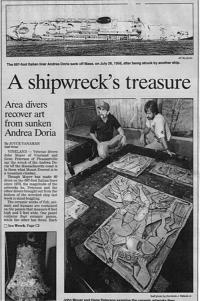
What is the Moyer’s method to finding a wreck on the seabed?
If you are looking for a certain wreck, you first have to research the history of it to get an approximate location of where it sank. Then, you check with fishermen to see if there are any known wrecks in the area. The next step would be to use side scan sonar or a magnetometer, then visual identification with either divers or an ROV (remotely operated vehicle). Of course, the best way to positively identify a wreck is to locate the bell or builder’s plaque. If not, then you compare underwater photos and measurements of the wreck to photos of the ship before it sank and compare cargo manifests to items you found on the wreck.
Amongst all the wrecks you dived, you choose the Andrea Doria as the wreck of your life. Why?
I first heard about the Andrea Doria wreck when I was taking a diving class in 1975. When I began reading about it, I learned that the collision and sinking was an important event in maritime history.
The first years I dived on the wreck, it was only for the adventure of diving on a wreck that very few people before me had seen, and most of the wreck was unexplored at that time. I then started to read and learn everything I could about the ship. I traveled to Italy to visit the Ansaldo Archives and met with some of the designers of the ship and officers who had been on board the night of the collision. I also met and interviewed many survivors of the sinking and others who had sailed on her.
Over the years, we have watched the Andrea Doria decay and fall apart. Today, the bow has remained intact but has broken off at Hold #2 and separated from the rest of the wreck; the aluminum superstructure is long gone, and the rusted steel hull is collapsing down on itself, crushing the interior rooms and anything left inside. The wreck has entered its final stage in a flattening process, and someday will be an unrecognizable pile of debris on the ocean floor.
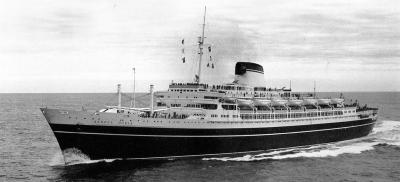
My first dives were exploratory, mostly swimming around the exterior of the wreck at the forward end of the promenade deck. I did not know a lot about the wreck at that time. In 1983, we began going inside the wreck, into the first-class dining room, where we found piles of dishes and china. After that, each year, we started exploring new areas of the wreck (inside and outside) that we had not been to before.
Do you think the Andrea Doria wreck has changed your life?
The Andrea Doria has certainly changed my life in many different ways. One example is that I have become very close friends with Pierette Simpson, who is a survivor of the sinking. I appeared in her film, Andrea Doria: Are the Passengers Saved? And we have done many presentations and film screenings together. We were also in the New York City Columbus Day Parade. At the end of the parade, they held a ceremony where Pierette rang the Andrea Doria bell in memory of the souls who died in the collision and sinking. Over one million people watched along the parade route and on livestream broadcast.
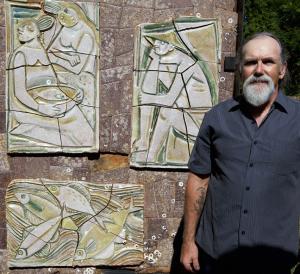
I knew that when the Andrea Doria was sailing, it was advertised as a floating art gallery. I learned that there were ceramic panels created by the artist Guido Gambone on board, but I did not know where they were located on the ship. A friend in Italy sent me a book that contained a photo of the panels in the ship’s Wintergarden Lounge. I was then able to match the photo with the ship’s deck plans and that showed me where to look on the wreck for the panels. When Billy Deans and I swam into that room, we found the panels right where we expected them to be.
Did you collect artifacts from the Andrea Doria wreck?
I have always enjoyed collecting artifacts from the wrecks I have dived on. I have lots of artifacts from many different wrecks. One of my favorites is a 5ft-diameter ship’s wheel that we recovered from a World War II wreck named the I.P. Goulandris. It is located off the coast of New Jersey, about 185ft deep. It took a team of divers to cut it free with a Broco touch and raise it. And we did it all in one day.
My artifact collection means a lot to me because each piece brings back memories of the dive and the experience of the day I recovered it. Because shipwrecks are continually deteriorating and falling apart, I feel that it is important to rescue these artifacts from the ocean before they are lost forever. It is also important to put them on display so the general public can learn about ships and maritime history.
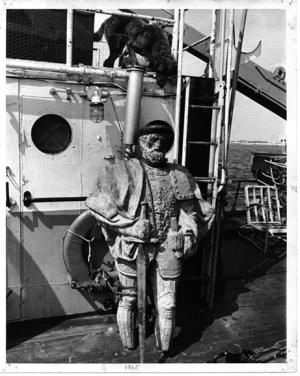
Did you rescue anything from the Andrea Doria?
On my very first dives to the Andrea Doria, I found a brass-framed window from the promenade deck and two small silver boxes that probably belonged to a passenger on board. In 1985, I was part of the team of divers that recovered the ship’s bell from the aft steering station. Gary Gentile and I recovered part of the Andrea Doria statue from the first-class lounge. We have also recovered hundreds of pieces of china, glassware and silverware from the ship’s dining rooms.
There was also a sculpture by the Italian artist Bertolotti on the wall of the first-class foyer. Gentile and I searched the area, but only found two pieces of it. The rest of the sculpture had fallen through a rusted hole into the bottom of the wreck.
In addition to the artifacts that I have recovered from the wreck, I have spent the last 40 years collecting all the Italian Line advertising items, photos and other things related to the ship that I could find. I have done many temporary museum exhibits over the years and hope someday to have a permanent exhibit dedicated to the Andrea Doria.
I decided it was best to recover the small fragile items first, like the dishes, china and glassware. Then, we brought up larger items like the Gambone panels. There are still large items like the ship’s anchors and propellers to be salvaged.
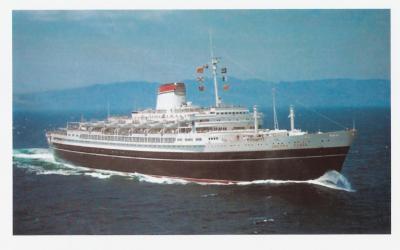
Do you consider the Andrea Doria wreck to be a part of American heritage?
The Andrea Doria is an important part of American history. In the four years it sailed, it carried thousands of Italian immigrants who came here to find jobs, start families, and begin a new life. Those immigrants helped to build America and make it the great country that it is today. Many of them, and their descendants, are still alive today.
The Andrea Doria was an important part of recent Italian history, because after World War II, it provided for many jobs (building the ship), and proved that Italy was a world leader in the maritime industry.
The first time you ever saw the Andrea Doria, did it appear to you as a ship or as a wreck?
I first dived on the Andrea Doria in June 1982. At that time, the funnel, mast, bridge and some top decks had already fallen off, but it still looked like a huge intact ship lying on its side on the sea floor. Swimming around it, we could see the portholes in the hull, windows on the promenade deck, and lifeboat davits on the boat deck. The port side bridge wing was still in place. There were commercial fishing nets snagged in the remaining superstructure, and most of the wreck was covered with sea anemones.
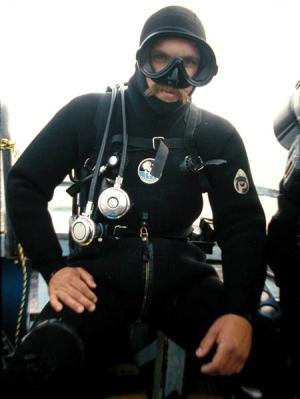
Can you describe to us the scuba techniques you adopted to dive the Andrea Doria?
The diving techniques used for the Andrea Doria were the same as is used in diving on other deep wrecks off the New Jersey coast. The dive boat would anchor onto the wreck with a grapple hook, and the first team of divers would take a second line down with just a chain on the end and secure it to the wreck.
Then, they would send the line with the grapple hook up, using a lift bag. Divers followed the anchor line down to the wreck and came up along it at the end of their dive to decompress.
For dive gear, I always wore a drysuit and double tanks, and I carried two knives, two lights, at least one lift bag and an upline (for decompression, in case we lost the anchor line). I also carried a hammer, chisel and crowbar too. Our early dives in the 1980s were done breathing compressed air and using the USN air decompression tables. Around 1992, we began using trimix with nitrox and oxygen for decompression.
I heard different tales about the Andrea Doria’s bell. Can you explain to me your point of view on this matter?
In 1985, my friend Bill Nagle had a plan to recover the Andrea Doria bell. There were seven of us on board. I was not able to dive because I had gotten the bends one week before while testing a Broco torch that we wanted to use on the trip.
We anchored in the bow of the wreck and the divers searched the area for three days. They found the davit that the bell had hung in, but it was empty. After that, we decided to move to the stern of the wreck and found a bell in the aft steering station. We stayed up most of the night making a net to put the bell in and sent it up the next day.
After I was awarded an Admiralty Arrest of the wreck in US federal court and was named salvor-in-possession of the wreck, I organized and financed two salvage expeditions. In the first expedition, I took a team of 12 divers on the research vessel Wahoo to the wreck for one week to search for the ship’s main bell. We used an air lift to vacuum out a room in the bow that I thought contained the bell.
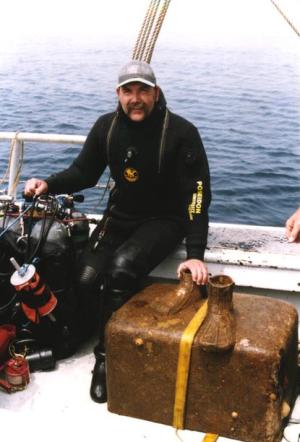
Unfortunately, we came home from that trip empty-handed. The next year, I took another team, again on the Wahoo, to the wreck for one week. One part of the team used the air lift to finish vacuuming out the room, but we did not find the bell. The other part of the team worked on recovering the two Gambone panels from the Wintergarden Lounge. Three years later, the Wintergarden Lounge fell apart and was gone. If we had not recovered the panels when we did, they would have been lost forever.
Once again, I am very curious. Please describe how you rescued the statue of Admiral Andrea Doria from the seabed of the Atlantic Ocean.
In 1964, Captain Dan Turner took a team of divers aboard the salvage ship Top Cat to recover the life-size bronze statue of Admiral Andrea Doria, which was in the first-class lounge. To get to the lounge, they had to blow a hole in the side of the wreck and then drop down to about 200ft inside the wreck to the statue. The statue was mounted on a pedestal, which was bolted to the deck. They could not unbolt the pedestal, so they decided to cut the statue off at the ankles using hacksaws.
In 1996, Gentile and I discovered that the statue’s pedestal had broken free from the deck and was now lying under a large piece of wreckage. It was the last dive of that trip, and we did not have the equipment with us to recover the pedestal. When I got back to shore, I had a special cable made up. On the next trip to the wreck, I crawled under the wreckage and wrapped the cable around the pedestal, and using a lift bag, dragged it out from under the wreckage. Next, I floated it up and set it down on the hull of the Andrea Doria. Then, I rigged it up with a heavy strap and sent it to the surface with a larger lift bag.
What does the spirit of the Andrea Doria represent to you?
Peter Gimbel was the first diver to dive on the wreck in 1956, and he led two other expeditions after that. I never met Gimbel in person, but I knew his wife, Elga Anderson. After they passed away, their family asked us to take their ashes to the wreck. I picked a site deep inside the wreck where they would never be found and disturbed.
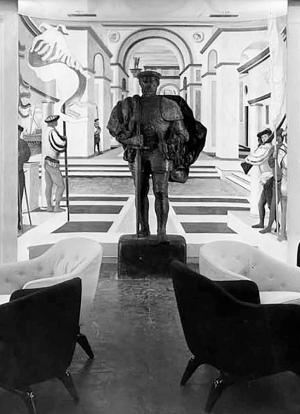
I became very good friends with Dan Turner, who led the expedition to recover the Andrea Doria statue. Before he passed, he would often call me to talk about the Andrea Doria. He came to my house in New Jersey many times, and I visited him at his home in Florida.
In 2006, Turner and his divers came to New Jersey to my 50th Anniversary Andrea Doria Exhibit at the Beneath the Sea convention. I still talk often to one of his divers, Denny Morse. I never got to meet Bruno Vailati, but we used to write letters to each other about diving on the wreck.
Of course, I was close friends with some of the other American divers who had visited the wreck before me, including George Hoffman, Mike deCamp and John Dudas. And I am still very close to the first woman to dive the wreck, Evelyn Dudas.
Gentile is one of my best friends. We have made many dives together on the Andrea Doria, Empress of Ireland and other wrecks, and he was on both my salvage expeditions.
What was the feeling you had the first time diving the Andrea Doria wreck
Every dive on the Andrea Doria is an adventure. When you enter the water, you never know what the conditions are like on the bottom. It may be good visibility with no current on the wreck, or there may be a strong current, or it may be dark with bad visibility. You have to be prepared to dive in whatever conditions you find.
While I was down on the wreck, sometimes I thought about how beautiful the ship was, both inside and out, when it was sailing, and how sad it is that it ended up lying on the bottom of the ocean. I also thought about the people who were on the ship and how they must have felt when the Stockholm hit the Andrea Doria and the terror they felt that night, not knowing if they would live or die.
Afterthoughts
In June 2022, the Noble Maritime Collection in Staten Island, New York, will present a new exhibition about the Italian liner SS Andrea Doria and the successful and well-documented rescue of her passengers after she was struck by the Swedish liner MS Stockholm on 25 July 1956, while en route to New York. The exhibition—which is hosted by the Noble, a museum directed by Ciro Galeano—will explore the beauty of the mid-century ship, which was described as a floating art museum, and her significance as the pride of post-WWII Italy. The museum staff is grateful to be working on this exhibition with Moyer, who was awarded salvage rights and named salvor-in-possession of the wreck in US federal court, as well as survivor Pierette Simpson, author of the nonfiction book, Alive on the Andrea Doria! The Greatest Sea Rescue in History, and the novel, I Was Shipwrecked on the Andrea Doria!

